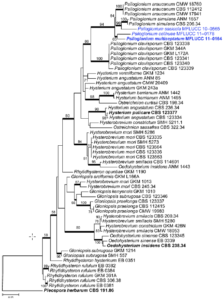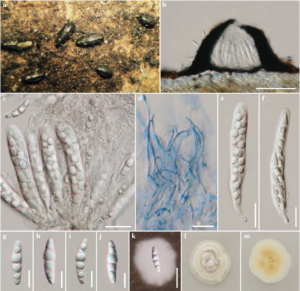Psiloglonium sasicola (N. Amano) E. Boehm & C.L.Schoch.
≡ Glonium sasicola N. Amano, Trans. Mycol. Soc. Japan 24(3): 287 (1983)
Index Fungorum number: IF515322, Facesoffungi number: FoF00433; Fig. 2
Saprobic on bamboo. Sexual morph Ascomata 130 – 180 μm high, 165 – 210 μm wide, hysterothecial, solitary to gregarious, scattered, superficial, dark, short to elongate, or irregular, rarely bifurcate, with central, slit-like opening. Peridium 20 – 40 μm wide, thick-walled, of unequal thickness, poorly developed at the base, slightly thick at sides, carbonaceous, opaque dark and glossy. Hamathecium 0.5 – 1.2 μm wide, composed of dense, trabeculate pseudoparaphyses, anastomosing, embedded in a hyaline to pale brown gelatinous matrix, slightly swollen at the apex. Asci (74–) 80 – 105 (–115) × 13 – 15 μm (x̄ = 92 × 14.3 μm, n = 25), 8 – spored, bitunicate, fissitunicate, cylindrical to cylindric-clavate, short pedicellate with knob-like pedicel, apically rounded with well-developed ocular chamber, easily broken in external layer. Ascospores (25–) 27 – 30 × 6 – 7 (–8) μm (x̄ = 28.3 × 6.8 μm, n = 30), overlapping 1–2-seriate, fusiform, with slightly roungends, hyaline, 1-septate, constricted at the septa, individaully upper cell larger than lower cell, smooth-walled, with small and large guttules, surrounded by wide mucilaginous sheath. Asexual morph Undetermined.
Culture characters – Colonies on MEA slow growing, reaching 30 – 35 mm diam. after 4 weeks at 25 – 30 °C, white to cream, or pale yellowish at the magins, pale yellowish at the centre, distinguished from the margin by white embossed hyphae with grey tufts in the centre; slightly radiating; dense, irregular, slightly raised to umbonate, dull with undulate edge, velvety to floccose, zonate in the centre at the lower part, reverse white cream at the margin, yellowish at the centre.
Material examined – THAILAND, Chiang Rai Province, Phan District, Poo Kaeng Waterfall, on dead branch of bamboo(Bambusae), 23 May 2010, R. Phookamsak RP0039 (MFLU 11–0159, reference specimen designated here), living culture, MFLUCC 10–0565; GenBank: ITS: KP744467; LSU: KP744513.
Notes – Psiloglonium sasicola was transferred to Psiloglonium by Boehm et al. (2009a, b) due to its didymosporous, fusiform hyaline, 1-septate ascospores with rounded ends, which are surrounded by gelatinous sheath (Boehm 2009; Boehm et al. 2009a, b). Psiloglonium sasicola is similar to P. uspallatense (Speg.) E. Boehm & C.L. Schoch and P. ephedrae (Henn.) E. Boehm & C.L. Schoch, but differs in the size of ascospores (Boehm 2009). Our collection is similar to P. sasicola and is from the same host bamboo. This isolate is treated as P. sasicola and is designated as a reference specimen (sensu Ariyawansa et al. 2014a). P. sasicola forms a robust clade in the phylogenetic tree with P.simulans (Fig. 1)

Fig. 1 Phylogram generated from Maximum likelihood (RAxML) analysis based on combined LSU, TEF and RPB2 sequence data. Maximum likelihood bootstrap support values greater than 50 % are indicated above or below the nodes, and branches with Bayesian posterior probabilities greater than 0.95 are given in bold. The ex-types (reference strains) are in bold; the new isolates are in blue. The tree is rooted with Pleospora herbarum CBS 191.86.

Fig. 2 Psiloglonium sasicola (MFLU 11–0159) a Black elongated ascomata lying on host surface b Section through ascoma c Asci embedded in pseudoparaphyses d Pseudoparaphyses stained by cotton blue e, f Asci g–j Ascospores k Ascospores stained in Indian ink l–m Culture characteristic. Scale bars: b = 100 μm, c, e, f, k = 20 μm, d, g – j = 10 μm.
